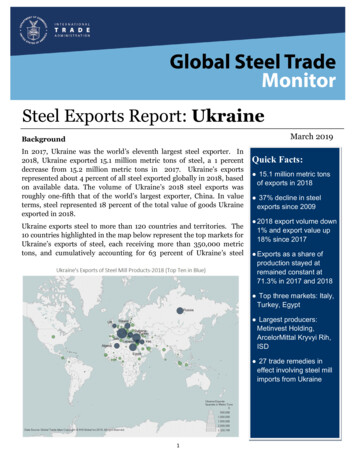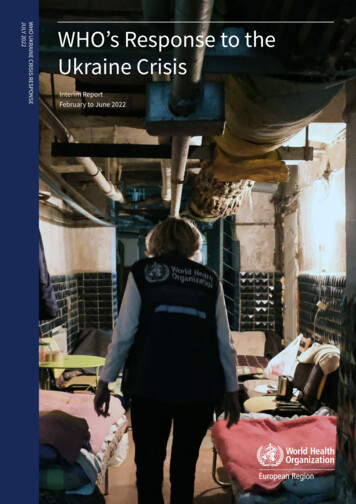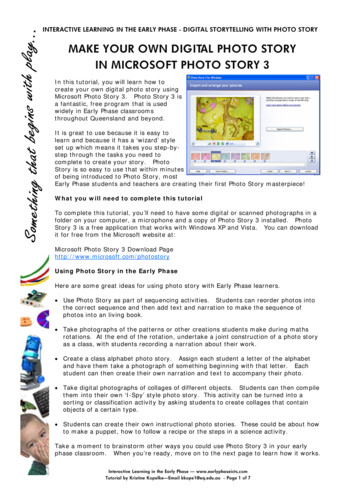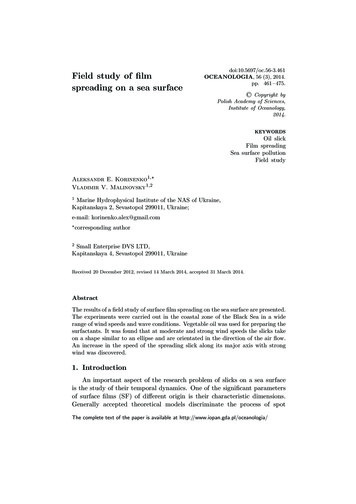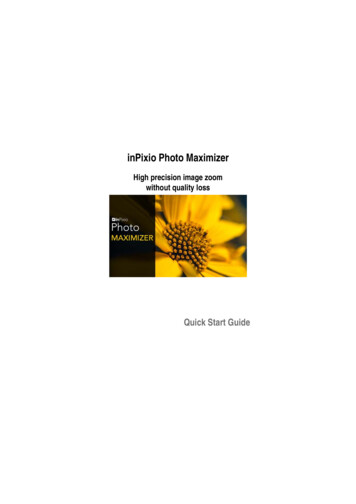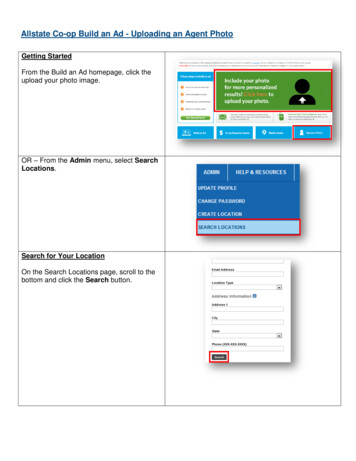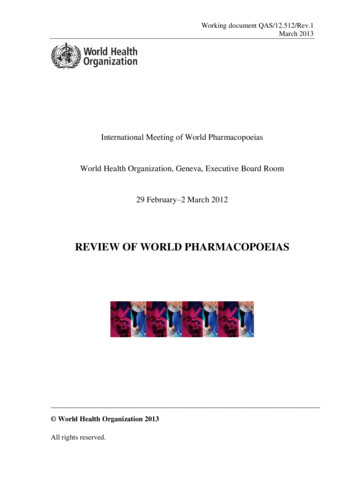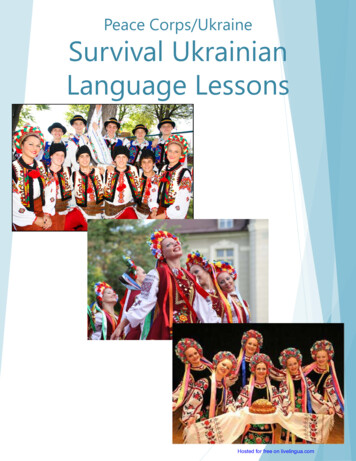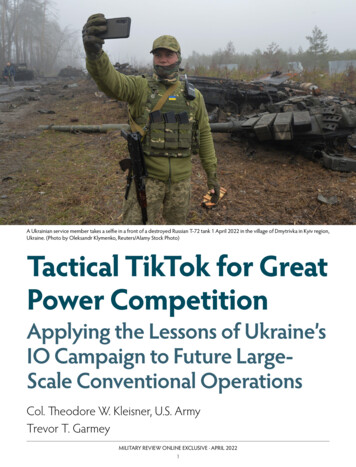
Transcription
A Ukrainian service member takes a selfie in a front of a destroyed Russian T-72 tank 1 April 2022 in the village of Dmytrivka in Kyiv region,Ukraine. (Photo by Oleksandr Klymenko, Reuters/Alamy Stock Photo)Tactical TikTok for GreatPower CompetitionApplying the Lessons of Ukraine’sIO Campaign to Future LargeScale Conventional OperationsCol. Theodore W. Kleisner, U.S. ArmyTrevor T. GarmeyMILITARY REVIEW ONLINE EXCLUSIVE · APRIL 20221
TACTICAL TIKTOKAs the first large-scale conventional conflictbetween near-peer adversaries since the 1973Yom Kippur War, the Russian invasion ofUkraine has provided warfighters a unique opportunityto assess prevailing assumptions about large-scale combat operations (LSCO) in real time. The conflict offerslessons spanning the full spectrum of U.S. arms, and itscampaigns must be carefully studied as the U.S. Armyfocuses on great-power competition.As we write, the conflict is barely four weeks old.Yet the impressive results of Ukraine military operations have already galvanized wholesale revisions toArmy tactical and strategic doctrine, ranging from thelethality of antitank guided missiles to the efficacy ofloitering munitions against lines of communication.But of all the lessons available to Army warfighters,the most significant is the role of information operations(IO) in modern LSCO. By empowering soldiers to rapidly distribute tactical information and shape a focusednarrative that seamlessly integrates battlefield imagery,heroic exploits, and evidence of potential Russian warcrimes, the Ukrainian military and its civilian leadershiphave mobilized the globe against Russia and contributedsubstantially to degrading enemy will. Meanwhile, theRussian military—purported experts at disinformationand cyberwarfare—has been utterly incapable of rebutting Ukrainian messaging or communicating a coherentexplanation of Russian war aims.Ukraine has achieved these results by merging commercial applications, including mobile devices, messagingservices, and social media, into its IO strategy and delegating distribution authority—by design or by default—to the tip of the spear.1 Ukraine has also merged strategiccommunications into its IO programming, empoweringUkraine warfighters to reinforce themes articulatedby their political leadership. The result is a stand-alonecombat capability that has rallied international support,allowed rapid dissemination of battlefield success, humiliated the adversary, and produced an authentic narrativethat resonates with target markets.For the U.S. Army, the Ukraine conflict offers atimely opportunity to review existing doctrine andconsider whether current Army IO and public affairs(PA) methodologies adequately leverage IO as a combat capability. More specifically, the Army must examine whether its existing IO and PA strategies addresswinning the information war at the point of contact.In this article, we first trace the evolution of IO;summarize Army and joint doctrine on IO, PA, andstrategic communications; and assess whether thepresent Army approach fully leverages the potential ofIO at the tactical level. We pay particular attention tothe failure of present IO doctrine to embrace winningthe IO fight at the point of contact. We then examinethe use of IO in Ukraine and argue that the experienceof the Ukraine army (UA) demonstrates that with appropriate training, guidance, and oversight, the tacticaldeployment of IO improves combat performance andis a necessary component of great power competition.Finally, we offer recommendations and considerationsfor the Army and the joint force to ensure that in thebattlefield of the future, warfighters can apply IO toneutralize adversaries and improve combat outcomes.Importantly, we do not purport to have all the answerson the integration of IO into Army doctrine. We do not,for example, address the implications of the Ukraineconflict for traditional information warfare—the useof sensors, software, and data to disrupt or destroy theinformation systems of the adversary. Access to the information required for that analysis is not available at thistime. Nor do we provide solutions to the inherent tensionbetween IO, information security, and information assurance. Instead, we mean for this article to be the catalyst forimportant conversations on the future of IO and how tobest position the Army for dominance in future LSCO.Historical Summary ofArmy IO InitiativesWhile this article is not a comprehensive history ofIO, a summary of recent Army efforts to explore andimplement IO helpsCol. Theodore W.explain current ArmyKleisner, U.S. Army,IO doctrine and itscommands 1st Brigade,application on future82nd Airborne Division.battlefields.A graduate of WestPoint, the National WarCollege, and the Schoolof Advanced InternationalStudies at Johns HopkinsUniversity, he has led unitsin peacekeeping and combat operations in Europe,Afghanistan, and Iraq.MILITARY REVIEW ONLINE EXCLUSIVE · APRIL 20222Trevor T. Garmey is anattorney in private practicein Los Angeles and agraduate of the Universityof Virginia School of Lawand the College of Williamand Mary.
TACTICAL TIKTOKThe Army’s IO and PA record during the SecondWorld War, Korea, Vietnam, and Operation DesertStorm has been the subject of detailed analysis and doesnot require further explication here.2 The most helpfulstarting point is instead the post-Cold War focus onfuture conflict, generally referred to as the revolution inmilitary affairs (RMA).U.S. Army Training and Doctrine Command Pamphlet525-5, Force XXI Operations: A Concept for the Evolutionof Full-Dimensional Operations for the Strategic Army ofthe Twenty-First Century, defined IO ascontinuous combined arms operationsthat enable, enhance, and protect the commander’s decision cycle and execution whileinfluencing an opponent’s operations areaccomplished througheffective intelligence,“The RMA also witnessed the first attempt bycommand and control,the Army to define IO. In a pattern that remainsand command and contrue, the Army framed IO as an ancillary attributetrol warfare operations,of combat operations, rather than a stand-alonesupported by all availablefriendly informationcombat capability.”systems; battle commandinformation operationsare conducted across theThe revolution in military affairs. Widely atfull range of military operations.7Two years later, Field Manual (FM) 100-6,tributed to Andrew Marshall and the Office of NetAssessment, RMA theory coalesced after the fall of the Information Operations, modified the definition tocontinuous military operations within theSoviet Union.3 RMA advocates focused on the potential for technology—including information technolomilitary information environment that enable,gy—to drive rapid change in warfare.enhance, and protect the friendly force’sThe RAND Corporation’s 1996 treatise, Strategicability to collect, process, and act on inforInformation Warfare: A New Face of War, is a usefulmation to achieve an advantage across theexemplar of RMA theory because it identifies “information” as a core domain of future conflict. Theauthors repeatedly emphasize the low entry costs ofinformation warfare, the security risks of growing network dependence, and above all, the potential for newtechnology to enhance deception techniques and allowthe manipulation of public perception.4For the Army, RMA theories found their first expression in “Force XXI,” a catchall for efforts preparing theforce for operations in a unipolar world.5 As stated byLt. Gen. Paul E. Menoher Jr. in “Force XXI: Redesigningthe Army through Warfighting Experiments,” the Armysought to “push[] the envelope and transform[] intoan even better information age, knowledge- and capabilities-based Army, capable of land force dominance acrossthe continuum of 21st century military operations.”6The RMA also witnessed the first attempt by theArmy to define IO. In a pattern that remains true, theTo view Strategic Information Warfare: A New Face of War, visitArmy framed IO as an ancillary attribute of onograph reports/2005/MR661.pdf.operations rather than a stand-alone combat capability.MILITARY REVIEW ONLINE EXCLUSIVE · APRIL 20223
TACTICAL TIKTOKfull range of military operations; IO includeinteracting with the GIE (Global InformationEnvironment) and exploiting or denying an adversary’s information and decision capabilities.8Thus, even early RMA advocates classified IO bytechnical features rather than war-making potential.This dynamic was highlighted by Robert J. Bunker in1998. Bunker questioned whether IO was properlyclassified as a force multiplier serving existing combatfunctions or as a stand-alone capability for the warfighter to exploit in the combat environment.9 Bunker statedthat the “actual value” of IO was disputed becauseOne school of thought posits that [IO] represent an adjunct to current operations—theend result of which is to enhance current Armycapabilities by making what it has traditionally done better by means of a force multipliereffect. Another school of thought suggests thatinformation operations will provide the Armywith new capabilities. Instead of being a simpleadjunct to current operations, according to thisschool, the influence of the “information revolution” on warfare will result in the redefinitionof operations themselves.10Those who saw IO as a force multiplier focused on theability of IO to identify, geolocate, and neutralize an adversary using sensors, high-speed data transmission, andimagery. Warfighters who saw IO as a stand-alone capability, by contrast, tended to focus more on the potentialfor information itself to impose substantial costs on anadversary, whether through the elimination of electronicsystems or the dissemination of adverse content.There were also debates about what preciselyinformation meant in the context of IO and the RMA.None of the Army publications cited above offered aclear definition for “information.” The Joint Chiefs ofStaff offered a concise definition in 1997, describinginformation as “data collected from the environmentand processed into usable form.”11 Data, meanwhile,was defined as “representations of facts, concepts, orinstructions in a formalized manner suitable for communications, interpretation, or processing by humansor automated means.”12Gen. Gordon Sullivan, by contrast, offered a morenuanced and functional definition of information thatfocused on the character of the data involved. Writingin War in the Information Age, Sullivan identified fourdistinct types of information: content information, “thesimple inventory of information about the quantity,location and types of items”; form information, “thedescriptions of the shape and composition of objects”;behavior information, “three dimensional simulationthat will predict behavior of at least physical objects, ultimately being able to ‘wargame’ courses of action”; andaction information, “information that allows operationsto take the appropriate action quickly.”13Regardless of these semantic debates—which continue to this day—by 2001, IO was a featured aspect of theBush administration’s revisions to national defense policy.IO was identified as a “key military capability” for the future joint force in the 2001 Quadrennial Defense Review.14Two years later, the Department of Defense issued itsInformation Operations Roadmap, intended to serve as ablueprint for the development of IO capabilities.15 Theroadmap recommended the creation of a “well-trained”IO workforce, and identified IO as a “core competency”for warfighters, stating “the importance of dominating theinformation spectrum explains the objective of transforming IO into a core military competency on par withair, ground, maritime, and special operations.”16The Global War on Terrorism. Despite theseaggressive mandates, the intervening years—and theGlobal War on Terrorism (GWOT)—did not resultin widespread deployment of Army IO capabilities.Said another way, while the GWOT demonstrated thepotential benefits of IO, the application of IO in a staticcounterinsurgency environment arguably institutionalized many habits that may not readily translate toLSCO. As an example, the staffing, centralization, andwithholding of IO authority at echelons above brigade(EAB)—a central attribute of current Army IO doctrine—may limit the Army’s ability to deploy IO in afast-paced LSCO environment.In fact, third-party experts noted deficiencies inArmy IO from the outset of the GWOT.17 And whileArmy IO arguably improved during the GWOT, it isdifficult to assess the overall impact of IO on adversaries because the targets often lacked meaningful accessto digital devices and were arguably less susceptible toAmerican influence than potential near-peer opponents.To the Army’s credit, many senior commandersgranted IO deployment authority to battalion- andcompany-grade officers during the GWOT.18 This wasparticularly true for key leader engagements. Junior andMILITARY REVIEW ONLINE EXCLUSIVE · APRIL 20224
TACTICAL TIKTOKfield-grade officers were empowered to engage directlywith tribal elders, religious figures, and political leaders.19However, according to the Center for Army LessonsLearned, formal IO battle rhythm events that requiredextensive IO planning and outputs were concentratedat the division and joint task force levels, and largelyorchestrated by dedicated IO professionals and IOThe failure of the Army (and other service branches) to embrace IO across all combat functions wasimplicitly acknowledged by the Joint Chiefs of Staff in2018. The Joint Concept for Operating in the InformationEnvironment identified “information” as the seventhjoint function for the Armed Forces of the UnitedStates.25 Noting that “every joint force action, written orspoken word, and displayedor related image has informational aspects,” the documentdemanded that the service“In evaluating Army IO efforts during thebranches “shift how [they]GWOT, it is fair to question why junior andthink about information fromfield-grade officers were often encouraged toan afterthought to a foundational consideration for allbuild interpersonal relationships with centers ofmilitary activities.”26influence in Iraq and Afghanistan but excludedFor the Joint Chiefs tofrom other IO initiatives.”admit that IO was still anoperational afterthought—nearly twenty years afterthe publication of the 2001working groups at EAB.20 Meanwhile, officers at theQuadrennial Defense Review—speaks volumes aboutpoint of contact who sought to deploy IO as an alternathe failure of the joint force to recognize the importive to lethal force often faced cumbersome procedures,tance of IO and develop IO expertise and capabilitiesonerous questioning from targeting boards, and excruciacross all combat commands.ating approval timelines.21 In evaluating Army IO effortsduring the GWOT, it is fair to question why junior andfield-grade officers were often encouraged to build interpersonal relationships with centers of influence in Iraqand Afghanistan but excluded from other IO initiatives.Critics pointed to these and other deficiencies asthe GWOT progressed. Writing in 2007, Dr. DanielKuehl, professor of information warfare at the NationalDefense University, commented that the Army suffered from a deficit of “information strategists” with theability to “coordinate and exploit the contribution ofthe information component of power and the synergies it offers.”22 Several years later, Corey D. Schou,J. Ryan, and Leigh Armistead wrote in the Journal ofInformation Warfare that many of the same commandsconducting IO “over 15 years ago are still the keyagencies conducting IO, just renamed and slightlyexpanded, but with no true increase in scope andcapability.”23 The authors concluded “it is not surprisingthat in many ways, the Department of Defense [and byTo view the 2001 Quadrennial Defense Review report, visit https://default, the Army] are moving backwards with drennial/QDR2001.pdf?ver AFts7axkH2zWUHncRd8yUg%3d%3d.to [IO] strategy, capabilities, and scope.”24MILITARY REVIEW ONLINE EXCLUSIVE · APRIL 20225
TACTICAL TIKTOKThe Present State ofArmy IO DoctrineThe transition in Army focus from the GWOT tonear-peer competition—a policy shift that began inearnest in 2014 with the Russian invasion of Crimea andthe U.S. military’s shift in focus to the Indo-Pacific theater in response to increasing threats from China—gavethe Army an opportunity to rethink its IO strategy.Near-peer competition also arguably requires a different structural approach to Army IO. As noted above,senior commanders generally oversaw IO campaigns inIraq and Afghanistan, and delegated campaign executionto subject-matter experts (SME) who did not alwayspossess tactical experience at the point of contact. Withthe transition from low-intensity conflicts to LSCO,Army leadership reemphasized the need for combatarms to “win at the point of contact” in “all warfightingfunctions.”27 That principle now echoes throughoutArmy Doctrine Publication 6-0, Mission Command:Command and Control of Army Forces. For example, paragraph 1-26 instructs commanders in LSCO to preparemission orders that “focus on the purpose of an operation and essential coordination measures rather thanon the details of how to perform assigned tasks, givingsubordinates the latitude to accomplish those tasks in amanner that best fits the situation.”28Field Manual 3-13. Considering the growing needfor tactical IO capability, the demonstrated success ofIO efforts by near-peer competitors in Syria, and theArmy’s renewed emphasis on dominating LSCO at thepoint of contact, it is surprising that the Army’s primaryIO doctrines continue to reflect a centralized, hierarchical approach to IO deployment. FM 3-13, InformationOperations, published on 6 December 2016, does notcontain a single instruction for the tactical deploymentof IO by junior officers or noncommissioned officers(NCOs) in the field. Instead, the manual institutionalizes IO as a function executed primarily at EAB levels.As an initial matter, we note that much contentin FM 3-13 is quite relevant and useful for Armyprofessionals, regardless of rank. The manual offers aconcise definition of IO: “the integrated employment,during military operations, of information-relatedcapabilities in concern with other lines of operation toinfluence, disrupt, corrupt, or usurp the decision-making of adversaries while protecting our own.”29 Themanual identifies IO as an essential feature of allTo view Field Manual 3-13, Information Operations, visit https://armypubs.army.mil/epubs/DR pubs/DR a/pdf/web/FM%203-13%20FINAL%20WEB.pdf.combat operations.30 And the manual properly identifies the purpose of IO: to “create effects in and throughthe information environment that provide commanders decisive advantage over enemies and adversaries.”31Overall, FM 3-13 provides the Army with an outstanding conceptual foundation for IO.The critical area where we believe FM 3-13 (andArmy IO doctrine as a whole) requires revision,considering recent events in Ukraine, is the absenceof any specific guidance for or discussion of tacticalIO application.32 The current manual focuses on IOdeployment at the EAB level. The manual positionsbrigade and division staffs as the centerpiece of the IOinfrastructure but provides very limited guidance forfield-grade officers, junior officers, and NCOs to applyin conducting IO at the point of contact.Further, FM 3-13 does not encourage brigade andbattalion commanders to develop internal IO expertise.Instead, the manual briefly discusses the potential fordivision commanders to employ an IO specialist andprovides an extensive overview of the SMEs availableto senior commanders upon request. In other words,the manual seems to conceive of IO as a specialized capability with identical application across the spectrumof Army combat units, regardless of the function a unitserves or the theater where the unit deploys.MILITARY REVIEW ONLINE EXCLUSIVE · APRIL 20226
TACTICAL TIKTOKFuture LSCO will arguably feature a battle rhythmThere is a fundamental difference, in our view,requiring maneuver officers and their support staff—between instructing public affairs officers in providingrather than EAB SMEs—to plan and execute IO withinrudimentary training to soldiers and empowering thethe relevant commander’s intent. It is therefore criticalmost educated military force in history to make goodthat the IO field manuals not only discuss IO in accessidecisions about content creation and distribution. In anble language but also offer junior and field-grade officersenvironment where every noncombatant will have a mo33a practical framework for deploying IO in the field.bile device and the ability to immediately stream footageField Manual 3-61.Review of Field Manual 3-61,Communication Strategy andPublic Affairs Operations,“Future LSCO will arguably feature a battle rhythmproduces a similar result.34requiring maneuver officers and their supportThe manual devotes extensivestaff—rather than EAB SMEs—to plan and executeattention to the Army’s publicaffairs infrastructure, the trainIO within the relevant commander’s intent.”ing of public affairs officers,and the importance of unifiedmessaging across combat commands. The manual also provides detailed descriptionsof Army operations to the world, the failure of the Armyof messaging protocols and the translation of commandto develop doctrine that empowers every soldier toers’ intent into effective communications by the publicadvance favorable narratives and reinforce U.S. war aimsaffairs officer and subordinates. But the manual devotesleaves a glaring hole in Army LSCO capabilities.almost no attention to how combatants at the tip of theConvergence. Turning from doctrine to planning,spear—the junior officers and NCOs leading soldiersthe Army’s most significant future force initiative,in combat—can effectively communicate the strategicProject Convergence, also relegates IO to a subordiobjectives of the Army and the joint force, or reinforcenate discipline. Convergence, at its core, focuses on themessaging developed by commanders in the EAB.integration of capabilities from a multitude of domains,including information, and the synchronized deployment of those capabilities against an adversary atgreater speed and range to achieve decision dominance.Yet review of the Army Futures Command materials on Convergence—at least those within the publicdomain—show the same focus on command-level IOdeployment and the same preference for the moremachine-driven aspects of IO.35 Theoretically, theconcept of convergence compels the Army to match itsIO doctrine and techniques to an increasingly flat andinterconnected network of battlefield nodes from thepoint of contact to strategic headquarters.Present Army training programs for companyand field-grade officers. The absence of IO doctrine focused on tactical deployment would be less noteworthyif Army training programs for new officers, NCOs, andrecruits rectified the gap. That is unfortunately not thecase. The U.S. Army’s Maneuver Center of ExcellenceTo view Field Manual 3-61, Communication Strategy and Public Afcurriculum for the Maneuver Captain’s Career Coursefairs Operations, visit https://armypubs.army.mil/epubs/DR pubs/DR a/ARN34864-FM 3-61-000-WEB-1.pdf.(MCCC) does not contain an instructional block forMILITARY REVIEW ONLINE EXCLUSIVE · APRIL 20227
TACTICAL TIKTOKIO, and the Command and Tactics Directorate does notemploy IO professionals. Of the eight orders producedby students in the MCCC, only one includes a psychological operations team, and effective deployment of thatteam is immaterial to the student’s overall grade.36The Command and General Staff College (CGSC)includes a single two-hour block of instruction in itsstripped of intellectual pretense and unleashed at thetactical level. In many ways, the use of IO by the UArepresents the most comprehensive expression to dateof the RMA. RMA advocates envisioned a fully networked battlefield with each soldier as a node, capableof receiving and distributing information in real timeabout enemy movements, fires, capabilities, and morale.A few caveats are necessary here. First, we acknowledge that we write withoutthe benefit of a full record“The IO campaigns waged by Ukraine againstof UA operations and largeRussia are a perfect example of the efficacy of IOly rely on facts drawn fromwhen stripped of intellectual pretense and unthird-party reporting, socialmedia, and public statementsleashed at the tactical level.”from the UA and the government of Ukraine. Second, weacknowledge that we do notmonths-long curriculum to prepare majors to serve atcurrently have access to UA war plans, IO doctrine,EAB. To be fair, the IO lesson plan thoroughly reviewstraining manuals, or policies and procedures governingdoctrine and concepts and offers techniques for intethe use of mobile devices and social media by UA pergration IO planning into the military decision-makingsonnel. Third, the record that we do have is biased inand targeting processes. To our point, however, the lesfavor of content-based IO readily discernible from theson concentrates on actions at EAB with little focus onpublic domain. We do not currently have visibility intointegrating or enabling leaders at the point of contact.electronic warfare or psychological operations by theThe CGSC also offers an elective with approximatelyUA or efforts by the UA to disrupt Russian command,37thirty students attending each class.control, communications, computers, intelligence, surWhy is this significant? Because the MCCC and theveillance, and reconnaissance. Therefore, the findingsCGSC produce the majority of maneuver commandersbelow and our recommendations may require revisionat the company and battalion levels and develop mostas more facts come to light.officers assigned to battalion, brigade, and division staffFeatures of Ukraine IO strategy. As we write, thepositions. MCCC and CGSC graduates will thereforeUkraine army has not only weathered the initial stormplay a disproportionate role in the planning and execuof the Russian invasion, but after four weeks of contion of future LSCO. There is no question that futuretinuous combat, it has also begun to retake territoryLSCO will feature a contested information environmentpreviously occupied by Russian units. Before the conflictand cognitive domain. Absent independent study, few ofbegan, these results were inconceivable. The overwhelmthese officers will have any exposure to or training for IO. ing majority of pundits, military experts, and public offiIn light of the July 2018 mandate from the Jointcials in the United States and across the European UnionChiefs of Staff, instructing the joint force to prioritize IOanticipated a rapid Russian victory. That did not happen.and identifying information as the seventh joint function,Instead, the UA has inflicted tremendous damage onthe failure to incorporate IO as a foundational aspect ofRussian forces, and in the process, radically altered globalrecruit and officer training curricula is quite striking.perceptions of Russian military competence. Whilenumerous authors have commented on the unanticipatAnalysis of the Ukraineed weakness of Russian combat arms, perhaps the mostIO Campaignconcise summary of this remarkable transformation inThe IO campaigns waged by Ukraine againstperception came from CNA’s Michael Kofman. SpeakingRussia are a perfect example of the efficacy of IO whento War on the Rocks on 7 March 2022, KofmanMILITARY REVIEW ONLINE EXCLUSIVE · APRIL 20228
TACTICAL TIKTOKthe Winter War wasan accurate reflectionof then-existing Sovietcapabilities, training,and doctrine. Comparethat to the present moodamong policy makersin Washington. On 28March 2022, for example, the Washington Postreported that seniorDepartment of Defenseofficials were convincedthat Russia was effectively finished as a globalpower and ebullientabout the prospects forthe United States and itsallies in future competition with China.40So what has madethe difference? The anA group of Ukrainian men cheer as they take a Russian tank on a joyride on 2 March 2022. (Screenshotswer is simple. Ukraine,from Twitter/@666 mancer)whether by prewardesign or by postinvaremarked that he had spent much of the past decade atsion necessity, has taken the war viral—unleashing IO attempting to “convince the world that the Russian Armythe tactical level and weaving every heroic deed, everywas not twelve feet tall,” but now expected to spend theRussian misstep, and every successful combat operationnext decade attempting to convince policy makers thatinto a persuasive multimedia narrative that, when aggrethe Russian army was “not two feet tall.”38 Meanwhile,gated with ongoing success on the battlefield, has provenglobal support for Ukraine has reached heights that were largely invulnerable to Russian influence.unimaginable when the war began.We now attempt to isolate—from the thousandsObviously, much of the credit for these titanic opinof UA videos, social media postings, “tactical TikTok,”ion shifts in global opinion goes to the competence of the and pronouncements—the doctrinal foundation andUA and the leadership of Ukraine President Volodymyrcritical features of Ukraine’s IO campaign. Because theZelensky. But Ukraine is not the first underdog torelevant content is published across diverse platforms,achieve surprising results against a purportedly superiorincluding TikTok, Facebook, Telegram, Twitter, andadversary. In fact, the Soviet Union endured a similartoo many others to name, we focus less on specificexperience in the “Winter War” of 1939–1940, when itsexamples (and the resulting citations), and more on theinvasion of Finland resulted in horrendous casualties.general strategies and narrative themes that the UA hasBut the Winter War did not generate the sameused to successfully conduct IO.rapid revision i
mercial applications, including mobile devices, messaging services, and social media, into its IO strategy and dele - gating distribution authority—by design or by default— to the tip of the spear.1 Ukraine has also merged strategic communications into its IO programming, empowering Ukraine warfighters to reinforce themes articulated
